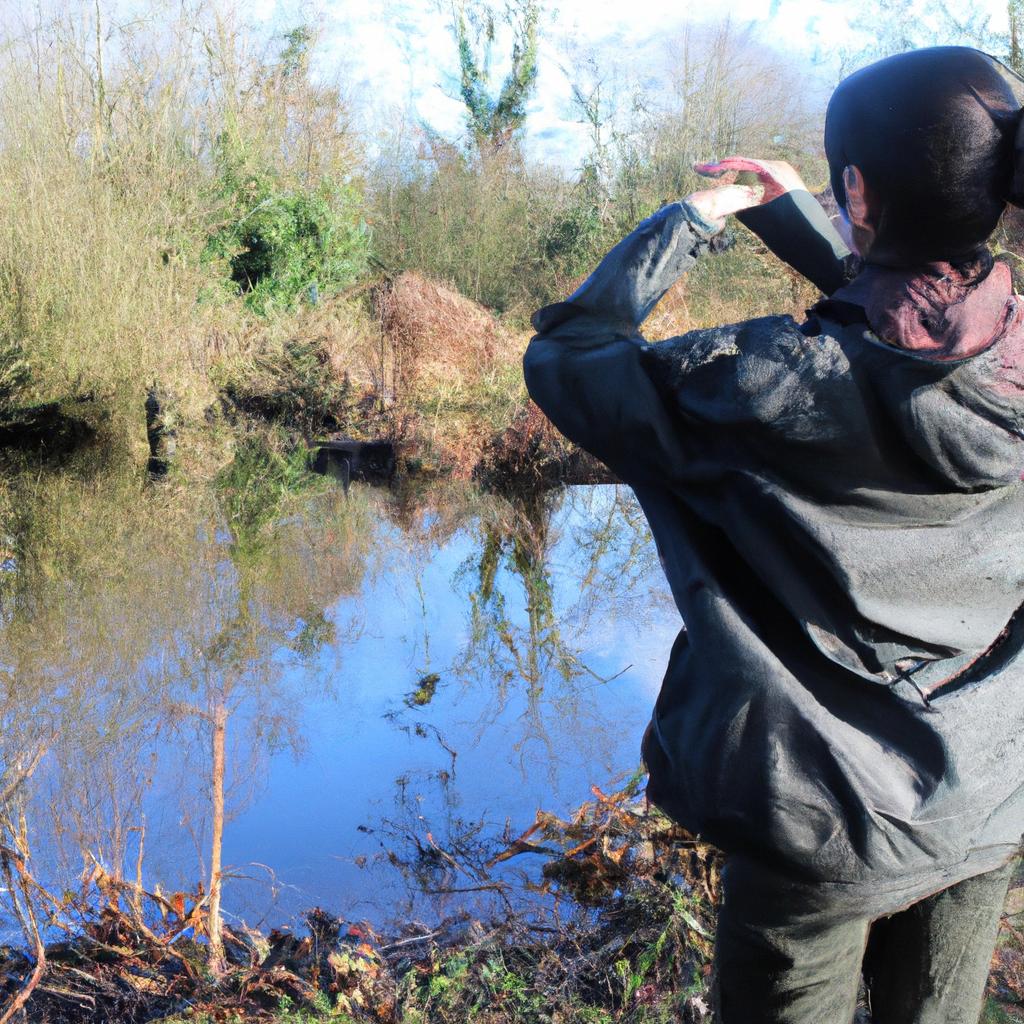Imagine a vast expanse of untouched wilderness, where towering mountains meet crystal-clear lakes and dense forests teeming with wildlife. This is the allure of national parks – protected areas that serve as havens for both nature enthusiasts and adventure seekers alike. One such example is Yellowstone National Park in the United States, renowned for its geothermal wonders and diverse ecosystems. However, beyond this iconic park lie numerous other hidden treasures waiting to be discovered by intrepid travelers. In this article, we will delve into the world of national parks, unveiling their mesmerizing beauty and exploring the endless opportunities they offer for sightseeing adventures.
National parks are not merely picturesque landscapes; they represent a commitment to conservation and preservation on a grand scale. These protected areas encompass unique natural features, rare species habitats, and significant cultural heritage sites. For instance, imagine journeying through Banff National Park in Canada, nestled amidst the awe-inspiring Canadian Rockies. Here, you can witness glaciers clinging precariously to mountaintops or spot elusive grizzly bears roaming freely across vast meadows. Moreover, these parks often hold historical significance as well – from ancient ruins to indigenous sacred grounds – providing visitors with an enriching experience that combines both reverence for nature and appreciation for human history.
Exploring the Untamed Wilderness: Discovering the National Parks’ Natural Wonders
Exploring the Untamed Wilderness: Discovering the National Parks’ Natural Wonders
Imagine standing at the edge of a deep and mysterious canyon, feeling the cool breeze against your face as you gaze into its vast expanse. This is just one example of the awe-inspiring natural wonders that can be found within our nation’s national parks. These protected landscapes offer an unparalleled opportunity for visitors to immerse themselves in the untamed wilderness and discover nature’s treasures.
National parks are home to a wide range of natural wonders, from towering mountains to pristine lakes and majestic waterfalls. One such park is Yosemite National Park located in California. With its iconic granite cliffs, ancient sequoia groves, and breathtaking vistas, it has captivated millions of visitors over the years. The park serves as a prime example of how national parks preserve unique ecosystems and provide habitat for diverse flora and fauna.
When exploring these natural wonders, there are several aspects that evoke a sense of wonder and appreciation:
- Breathtaking Landscapes: Picture yourself surrounded by snow-capped peaks or endless fields of wildflowers. The sheer beauty of these landscapes leaves visitors spellbound.
- Thrilling Wildlife Encounters: Spotting elusive creatures like grizzly bears or witnessing a bald eagle soar through the sky creates unforgettable moments filled with excitement.
- Rejuvenating Outdoor Activities: Whether hiking through rugged trails or kayaking along crystal-clear rivers, engaging in outdoor activities allows visitors to connect with nature on a personal level.
- Peaceful Serenity: Finding solace amidst untouched wilderness provides a much-needed escape from our bustling modern lives, offering tranquility and inner peace.
To further illustrate the significance of national parks, consider Table 1 below which highlights some remarkable statistics about three well-known parks:
| National Park | Size (acres) | Annual Visitors | Established Year |
|---|---|---|---|
| Yellowstone | 2,219,790 | 4.1 million | 1872 |
| Grand Canyon | 1,217,403 | 6.3 million | 1919 |
| Great Smoky Mtns. | 521,490 | 12.5 million | 1934 |
Table 1: Noteworthy National Parks and their Statistics
In conclusion, national parks offer a gateway to the wonders of nature that can captivate and inspire all who visit them. From breathtaking landscapes to thrilling wildlife encounters, these protected areas provide an opportunity for individuals to connect with the untamed wilderness on a profound level.
A Glimpse into History: Uncovering the Cultural Heritage of National Parks
Unveiling the Secrets: Journeying through National Parks’ Geological Marvels
Imagine standing at the edge of a deep canyon, gazing in awe as sunlight dances upon towering rock formations. This is just one example of the geological wonders that await visitors within our nation’s extraordinary national parks. These protected landscapes offer an unparalleled opportunity to witness the incredible power and beauty of nature’s forces, shaping breathtaking vistas for all who venture into their depths.
As we delve further into the exploration of national parks, it becomes evident that these natural treasures hold not only remarkable biological diversity but also fascinating geological features. From majestic mountains to ancient lava fields, each park possesses its own unique geological story waiting to be uncovered. Let us now embark on a journey through some of these captivating geological marvels:
-
Towering Peaks and Formidable Valleys:
- Witness the mighty granite cliffs of Yosemite National Park, sculpted by glaciers over millions of years.
- Stand in awe before the rugged grandeur of Grand Teton National Park, where snow-capped peaks rise dramatically from pristine lakes.
- Traverse the depths of Zion National Park’s narrow canyons, carved out by relentless rivers and wind erosion.
- Experience the vastness of Death Valley National Park, with its expansive salt flats and surreal badlands.
-
Ancient Volcanoes and Fiery Landscapes:
| Park | Notable Geological Feature |
|---|---|
| Hawai’i Volcanoes National Park | Kīlauea volcano continuously erupts, adding new land to Hawaii |
| Crater Lake National Park | Showcases a stunning caldera lake formed by a collapsed volcano |
| Lassen Volcanic National Park | Boasts volcanic features such as fumaroles, mud pots, and hot springs |
| Yellowstone National Park | Home to half of the world’s geysers, including the famous Old Faithful |
- Ancient Rocks and Fossilized Stories:
- Step back in time at Petrified Forest National Park, where ancient trees have turned to stone over millions of years.
- Discover the fossilized remains of prehistoric creatures preserved within Dinosaur National Monument’s rock layers.
- Marvel at the vibrant hues of Badlands National Park’s layered sedimentary rocks, revealing a rich history of changing environments.
These examples merely scratch the surface of the geological wonders found within national parks across our country. By exploring these captivating landscapes, we can gain a deeper understanding of Earth’s remarkable history and appreciate its awe-inspiring beauty.
Transitioning into the subsequent section on “An Oasis of Biodiversity: Delving into the Flora and Fauna of National Parks,” let us now turn our attention from the enduring rocks beneath our feet to the living organisms that call these parks home.
An Oasis of Biodiversity: Delving into the Flora and Fauna of National Parks
Uncovering the Cultural Heritage of National Parks
Imagine standing in the midst of ancient ruins, feeling a sense of awe as you gaze upon the remnants of civilizations long past. This is just one facet of the cultural heritage that can be discovered within national parks around the world. From archaeological sites to historical landmarks, these protected areas offer a glimpse into our collective history.
One fascinating example is Mesa Verde National Park in Colorado, USA. Here, visitors can explore the remarkably preserved cliff dwellings built by ancestral Pueblo people over 700 years ago. Walking through these intricate structures provides an intimate understanding of their ingenious architectural techniques and way of life.
To further indulge your curiosity about the rich cultural heritage found in national parks, consider the following:
- Diverse Indigenous Art: Many national parks showcase indigenous art that reflects centuries-old traditions and stories passed down through generations.
- Historical Trails: Follow in the footsteps of explorers and settlers along historic trails that crisscross national parks, offering insights into pioneering journeys and significant events.
- Museums and Interpretive Centers: Numerous parks house museums or interpretive centers where artifacts are displayed and educational programs help visitors delve deeper into the park’s cultural significance.
- Cultural Festivals: Some national parks organize special festivals or events celebrating local cultures, providing opportunities for interaction with traditional music, dance, crafts, and cuisine.
To illustrate this diversity further, let us take a look at a few examples from different continents:
| National Park | Country | Cultural Heritage |
|---|---|---|
| Tikal | Guatemala | Ancient Mayan city surrounded by lush rainforests |
| Serengeti | Tanzania | Rock paintings depicting wildlife migrations |
| Uluru-Kata Tjuta | Australia | Sacred site for Aboriginal Australians |
| Royal Chitwan | Nepal | Traditional Tharu village showcasing unique customs |
By immersing ourselves in the cultural heritage of national parks, we gain a deeper appreciation for the interconnectedness of humanity throughout time. As we continue our exploration of these remarkable protected areas, let us now turn our attention to the incredible biodiversity they harbor.
Thrilling Outdoor Activities: Engaging in Adventure Sports in National Parks
The Treasure Troves: National Parks Unveiled for Sightseeing Adventures
The rich biodiversity found within national parks provides a captivating opportunity to explore and appreciate the wonders of nature. One such example is Yosemite National Park, located in California’s Sierra Nevada Mountains. Its diverse ecosystems offer a glimpse into the intricate web of life that exists within these protected areas.
Within Yosemite National Park, an encounter with the charismatic American black bear showcases the park’s thriving wildlife population. These majestic creatures are known for their strength and adaptability, making them excellent climbers and swimmers. Observing a black bear in its natural habitat can be both awe-inspiring and humbling, reminding us of our place in this vast ecosystem.
To fully comprehend the significance of biodiversity within national parks, consider the following:
- The sheer variety of plant species present offers visual splendor as well as essential habitats for countless organisms.
- Animal populations demonstrate extraordinary adaptations to survive challenging environmental conditions.
- Ecological balance ensures interdependence among different species, creating delicate harmony.
- Preservation efforts contribute to safeguarding genetic diversity and preventing potential extinctions.
Through careful documentation and research, scientists have compiled invaluable information about the flora and fauna inhabiting national parks. This knowledge aids conservation strategies worldwide while also raising awareness about the importance of protecting these fragile ecosystems.
| Ecosystem Services | Conservation | Education |
|---|---|---|
| Climate regulation | Habitat preservation | Environmental awareness |
| Water purification | Biodiversity studies | Nature appreciation |
| Soil stabilization | Sustainable practices | Scientific discovery |
| Pollination support | Species reintroduction | Wildlife conservation |
By recognizing the multitude of benefits provided by national parks’ biological treasures, we cultivate empathy towards all living beings sharing this planet. Moreover, understanding the intricate relationships within these ecosystems inspires a deep sense of responsibility to protect and conserve them for future generations.
National parks serve as tranquil retreats, offering respite from the hustle and bustle of modern life. These serene landscapes provide an escape into nature’s embrace, allowing individuals to reconnect with their inner selves while immersing in awe-inspiring surroundings.
Connecting with Nature: The Tranquil Retreats of National Parks
Transitioning from the previous section, let us now explore another facet of national parks that offers visitors a chance to connect with nature on a deeper level. Through serene retreats and awe-inspiring landscapes, these natural havens provide an escape from the bustling pace of modern life.
Imagine standing at the edge of a crystal-clear lake as the sun sets behind towering mountains, casting hues of orange and pink across the sky. This picturesque scene is just one example of the tranquil beauty found within our national parks. Whether it’s strolling along peaceful forest trails or meditating beside cascading waterfalls, these pristine environments offer rejuvenation for weary souls seeking solace amidst nature’s wonders.
To fully immerse oneself in the serenity of national parks, here are some key elements that contribute to their allure:
-
Breathtaking Scenic Beauty:
- Vast expanses of untouched wilderness
- Majestic mountain ranges and deep canyons
- Lush forests teeming with diverse flora and fauna
- Iconic landmarks like grand arches or towering sequoias
-
Peaceful Seclusion:
- Remote locations away from urban congestion
- Limited cellphone reception encourages digital detoxification
- Tranquil camping grounds for overnight stays under starlit skies
- Opportunities for introspection and self-discovery
-
Ecological Diversity:
- Habitats supporting rare and endangered species
- Protected ecosystems fostering biodiversity conservation efforts
- Educational programs promoting environmental awareness and sustainability
- Preservation of cultural heritage intertwined with natural landscapes
-
Therapeutic Benefits:
- Stress reduction through immersion in nature’s tranquility
- Increased physical activity through hiking, walking, or kayaking
- Improved mental well-being and clarity of thought
- Sense of awe and wonder that nourishes the soul
These elements collectively create an environment where visitors can find solace, connect with their surroundings, and appreciate the true magnificence of our natural world. National parks serve as gateways to experiences that are not only visually breathtaking but also emotionally enriching.
Transitioning into the subsequent section about “Protecting Our Natural Treasures: Understanding the Conservation Efforts in National Parks,” we begin to delve deeper into how these stunning landscapes are preserved for future generations to enjoy. By exploring conservation initiatives within national parks, we gain a greater understanding of the steps taken to safeguard these invaluable treasures.
Protecting Our Natural Treasures: Understanding the Conservation Efforts in National Parks
As we delve deeper into the wonders of national parks, it is essential to recognize the vital role they play in preserving our natural treasures. Through various conservation efforts, these pristine landscapes continue to thrive and provide invaluable benefits for both present and future generations. Let us now explore some key aspects of the remarkable conservation initiatives undertaken within national parks.
Conservation Initiatives in Action:
To illustrate the positive impact of these endeavors, let’s consider a case study involving Yosemite National Park in California. Facing challenges due to climate change and increasing visitor numbers, park authorities implemented several measures to protect its fragile ecosystem. These included promoting sustainable tourism practices, implementing wildlife management programs, restoring damaged habitats through reforestation projects, and engaging local communities in educational outreach programs.
The significance of such conservation initiatives goes beyond just one park. Here are four reasons why these efforts deserve our attention and support:
- Biodiversity Preservation: By safeguarding diverse ecosystems within national parks, we ensure the survival of numerous plant and animal species that may be endangered elsewhere.
- Climate Change Mitigation: Preserved forests act as carbon sinks, absorbing greenhouse gases from the atmosphere and contributing towards mitigating climate change impacts.
- Water Resource Protection: Many national parks encompass watersheds that serve as sources for freshwater supply systems, ensuring clean water availability for countless communities downstream.
- Cultural Heritage Conservation: National parks often hold significant cultural value by protecting indigenous sites or historical landmarks, allowing future generations to connect with their heritage.
Table – Economic Benefits Generated by National Parks (Example):
| Economic Benefit | Example |
|---|---|
| Tourism Revenue | In 2020 alone, Yellowstone National Park generated $493.6 million in tourism |
| revenue, supporting local businesses and stimulating regional economies. | |
| Job Creation | The Great Smoky Mountains National Park sustains approximately 20,000 jobs in |
| the surrounding region, providing employment opportunities for locals. | |
| Educational Programs | Acadia National Park offers educational programs that engage over 10,000 |
| students annually, fostering environmental awareness and knowledge. |
In summary, national parks are not merely picturesque retreats but also vital conservation hubs where dedicated efforts ensure the protection of our natural heritage. Through initiatives like sustainable tourism practices, wildlife management programs, habitat restoration projects, and community engagement, these parks continue to thrive while benefiting both ecosystems and human societies. By understanding and appreciating the significance of these conservation endeavors within national parks, we contribute to their preservation for generations to come.
[End of section]










